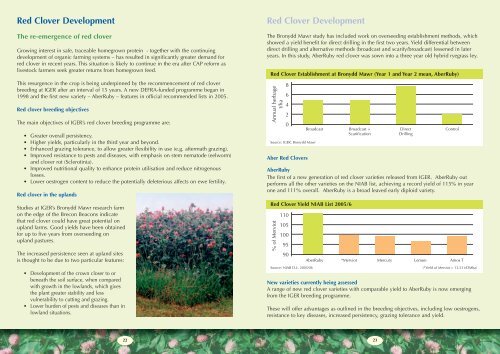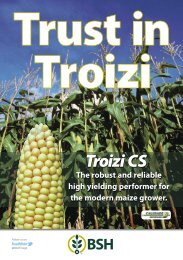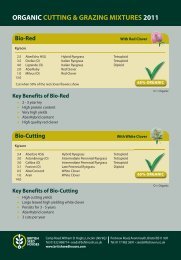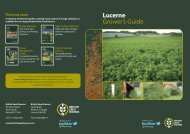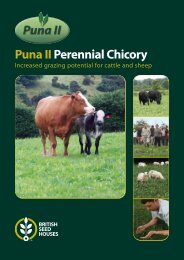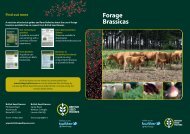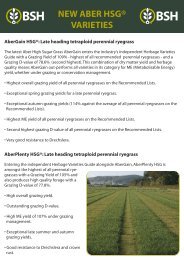You also want an ePaper? Increase the reach of your titles
YUMPU automatically turns print PDFs into web optimized ePapers that Google loves.
Red <strong>Clover</strong> Development<br />
The re-emergence of red clover<br />
Growing interest in safe, traceable homegrown protein - together with the continuing<br />
development of organic farming systems – has resulted in significantly greater demand for<br />
red clover in recent years. This situation is likely to continue in the era after CAP reform as<br />
livestock farmers seek greater returns from homegrown feed.<br />
This resurgence in the crop is being underpinned by the recommencement of red clover<br />
breeding at IGER after an interval of 15 years. A new DEFRA-funded programme began in<br />
1998 and the first new variety – <strong>Aber</strong>Ruby – features in official recommended lists in 2005.<br />
Red clover breeding objectives<br />
The main objectives of IGER’s red clover breeding programme are:<br />
• Greater overall persistency.<br />
• Higher yields, particularly in the third year and beyond.<br />
• Enhanced grazing tolerance, to allow greater flexibility in use (e.g. aftermath grazing).<br />
• Improved resistance to pests and diseases, with emphasis on stem nematode (eelworm)<br />
and clover rot (Sclerotinia).<br />
• Improved nutritional quality to enhance protein utilisation and reduce nitrogenous<br />
losses.<br />
• Lower oestrogen content to reduce the potentially deleterious affects on ewe fertility.<br />
Red clover in the uplands<br />
Studies at IGER’s Bronydd Mawr research farm<br />
on the edge of the Brecon Beacons indicate<br />
that red clover could have great potential on<br />
upland farms. Good yields have been obtained<br />
for up to five years from overseeding on<br />
upland pastures.<br />
The increased persistence seen at upland sites<br />
is thought to be due to two particular features:<br />
• Development of the crown closer to or<br />
beneath the soil surface, when compared<br />
with growth in the lowlands, which gives<br />
the plant greater stability and less<br />
vulnerability to cutting and grazing.<br />
• Lower burden of pests and diseases than in<br />
lowland situations.<br />
Red <strong>Clover</strong> Development<br />
The Bronydd Mawr study has included work on overseeding establishment methods, which<br />
showed a yield benefit for direct drilling in the first two years. Yield differential between<br />
direct drilling and alternative methods (broadcast and scarify/broadcast) lessened in later<br />
years. In this study, <strong>Aber</strong>Ruby red clover was sown into a three year old hybrid ryegrass ley.<br />
Red <strong>Clover</strong> Establishment at Bronydd Mawr (Year 1 and Year 2 mean, <strong>Aber</strong>Ruby)<br />
Annual herbage<br />
t/ha<br />
<strong>Aber</strong> Red <strong>Clover</strong>s<br />
<strong>Aber</strong>Ruby<br />
The first of a new generation of red clover varieties released from IGER. <strong>Aber</strong>Ruby out<br />
performs all the other varieties on the NIAB list, achieving a record yield of 115% in year<br />
one and 111% overall. <strong>Aber</strong>Ruby is a broad leaved early diploid variety.<br />
Red <strong>Clover</strong> Yield NIAB List 2005/6<br />
110<br />
105<br />
100<br />
95<br />
90<br />
<strong>Aber</strong>Ruby *Merviot Mercury Lemon Amos T<br />
Source: NIAB D.L. 2005/06<br />
(*Yield of Merviot = 13.23 t/DMha)<br />
% of Merviot<br />
8<br />
6<br />
4<br />
2<br />
0<br />
Source: IGER, Bronydd Mawr<br />
Broadcast Broadcast + Direct Control<br />
Scarification<br />
Drilling<br />
New varieties currently being assessed<br />
A range of new red clover varieties with comparable yield to <strong>Aber</strong>Ruby is now emerging<br />
from the IGER breeding programme.<br />
These will offer advantages as outlined in the breeding objectives, including low oestrogens,<br />
resistance to key diseases, increased persistency, grazing tolerance and yield.<br />
22 23


